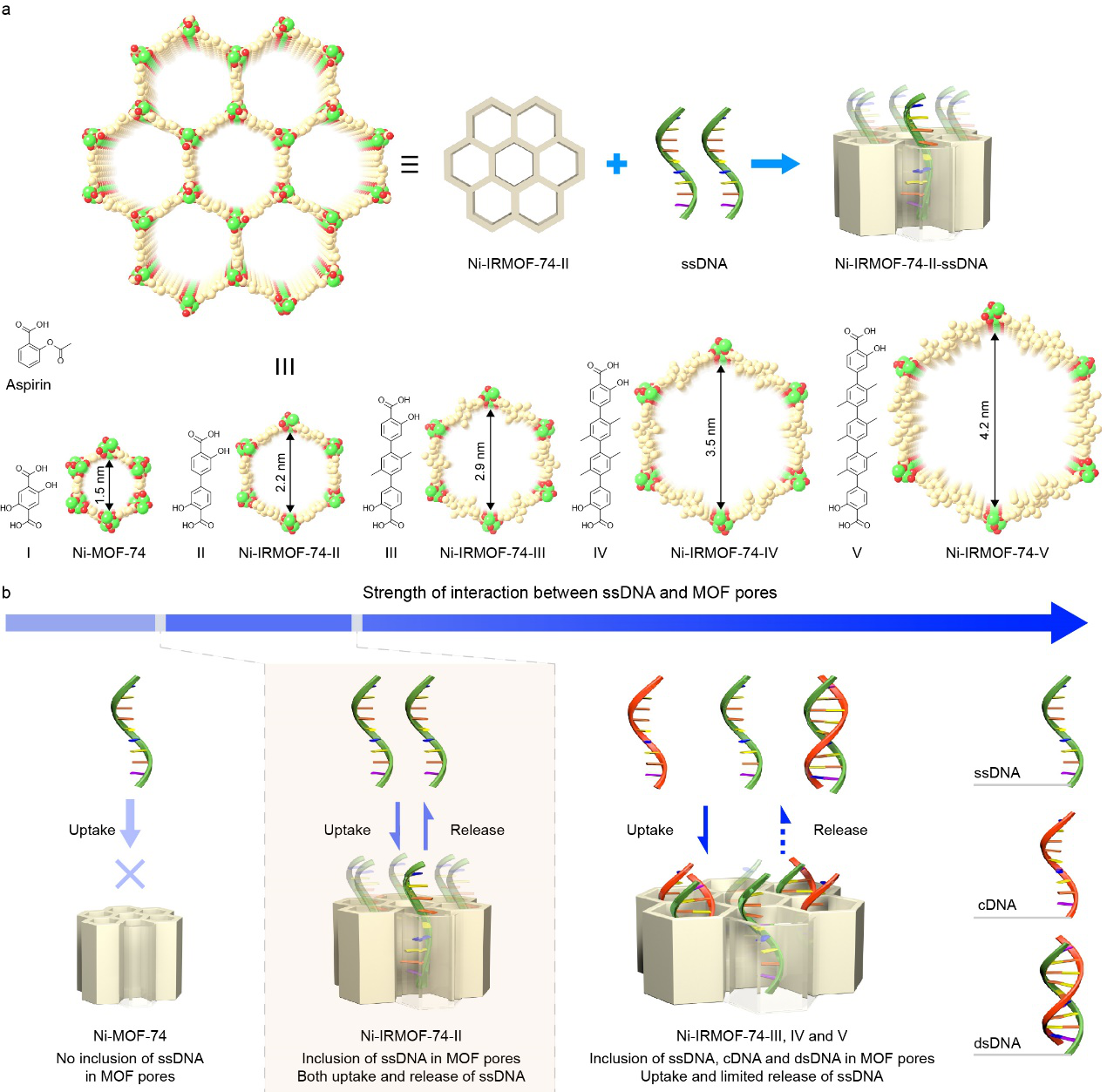Interaction mode and gene transfection efficiency in immune cells were studied by Xiang Zhou’s and Hexiang Deng’s Group in Wuhan University, published on Nature Communications (DOI:10.1038/s41467-018-03650-w).
Porous metal-organic frameworks (MOFs) are well-known for their ability to bind and release small gas and organic molecules in a precise manner. However, few studies have exploited this precision in incorporating large biological molecules and releasing them on demand. Effective transfection of genetic molecules such as DNA usually relies on vectors that can reversibly uptake and release these molecules and protect them from digestion by nuclease. Non-viral vectors meeting these requirements are rare due to the lack of specific interactions with DNA. Here, we design a series of four isoreticular metal-organic frameworks (Ni-IRMOF-74-II to -V) with progressively tuned pore size from 2.2 to 4.2 nm to precisely include single stranded DNA (ssDNA, 11-53 nt), and to achieve reversible interaction between MOFs and ssDNA. The entire nucleic acid chain is completely confined inside the pores providing excellent protection, and the geometric distribution of the confined ssDNA is visualized by X-ray diffraction.
Intracellular delivery of biomolecules is essential in biological research and therapeutic applications and gene editing. One of the major obstacles for their clinical application is the lack of safe, efficient and low-cost delivery methods, especially for stem cells and immune cells, which are the most difficult to transfect but also the most exciting target cell types in gene therapy. These two MOFs in this series exhibit excellent transfection efficiency in mammalian immune cells, 92% in the primary mouse immune cells (CD4+ T cell) and 30% in human immune cells (THP-1 cell), unrivaled by the commercialized agents (Lipo and Neofect).

The latest research results were published online on April 3rd, 2018 on Nature Communications with the title ‘Metal-Organic Frameworks for Precise Inclusion of Single Stranded DNA and Transfection in Immune Cells’. In this report, researchers from Wuhan University used these MOFs for the delivery of ssDNA into immune cells that cannot be effectively transfected by conventional transfection agents, and found that the Ni-IRMOF-74-II and -III with the lowest strength of interaction between ssDNA and MOF pores showed a remarkable potential in intracellular delivery.
The research team in College of Chemistry & Molecular Sciences of Wuhan University, China, was led by Prof. Xiang Zhou and Prof. Hexiang Deng. Shuang peng and Binglin Bie are co-first author, the other authors, Yangzesheng Sun, Min Liu, Hengjiang Cong, Wentao Zhou, Yucong Xia, Heng Tang also made significant contributions. This research was financially supported by the National Key Research and Development Program of China. (2017YFA0402800, 2017YFA0403000). The authors thank beamline BLB14B1 (Shanghai Synchrotron Radiation Facility) for providing the beam time and helps during experiments. Structural characterizations were provided by the test center and Core Research Facilities of Wuhan University. Support for the synthesis and applications of MOFs were provided by the 1000 Talent Plan of China, the National Natural Science Foundation of China (21471118 and 91545205 to HD, 21432008, 21721005 and 91753201 to XZ), Key Program of Hubei Province (2015CFA126), Innovation Team of Wuhan University (2042017kf0232) and National Key Basic Research Program of China (2014CB239203).
Linkage of the paper: https://www.nature.com/articles/s41467-018-03650-w
Deng Group website: http://hdeng.whu.edu.cn
(Reported by Shuang Peng)
